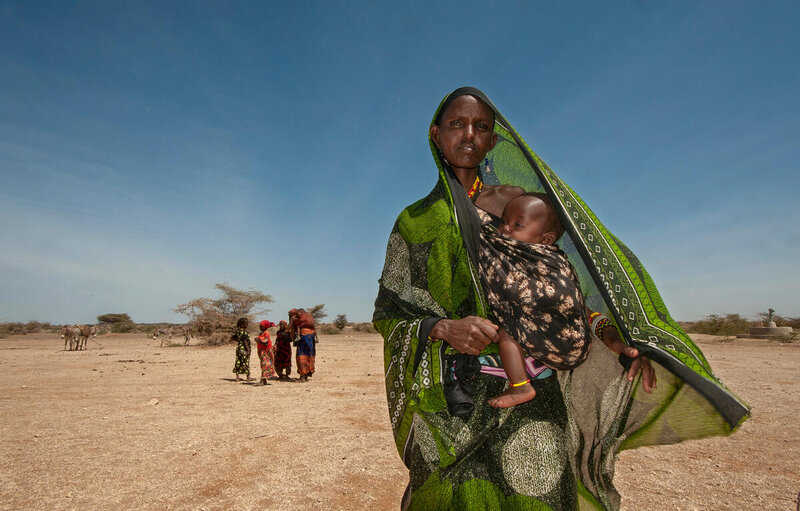Following the failure of four rainy seasons over two years, at least 36 million people across the Horn of Africa region are suffering from the effects of a prolonged drought, with 21 million people highly food insecure. This is equivalent to the combined populations of Denmark, Portugal and New Zealand.

In parts of Somalia, the situation is projected to reach famine levels if humanitarian aid is not significantly increased. It's a disaster like nothing we have seen in the last 40 years. Yet the world's attention is elsewhere. The ongoing conflict in Ukraine has pushed the Horn of Africa drought off newspapers' front pages and away from donors' attention, whilst also increasing food prices and reducing availability of grain imports. Lives are being lost as a result.
The humanitarian situation in the region is dire due to this severe drought. Almost two million children across Ethiopia, Kenya and Somalia require urgent treatment for life-threatening severe acute malnutrition. The drought has killed vast swathes of crops, pasture and livestock and dried up water sources, leading to more than 1.7 million people across these three countries fleeing their homes. Over 9 million livestock have died across the three countries and fifteen million children are out of school. The number of people without reliable access to safe water has risen to 16.2 million, leading to outbreaks of cholera and diarrhoea across the region. With a fifth rainy season already failing, livelihoods have been stretched to the point of no return.
This is a taste of what is to come for the wider world in the coming decades, with climatic shocks becoming more frequent and severe. And here is another reason why the world cannot afford to ignore this disaster - it is driven by climate change. In order to deal with the drought in the Horn of Africa, we need to not only respond to people's immediate needs but also to build their resilience to adapt to and cope with climate change. Dealing with drought in the Horn of Africa will teach us vital lessons about dealing with future climate change challenges around the world.
Lastly, this is an equity issue. Research has shown that the countries least responsible for climate change are the ones bearing the brunt of its impact. Somalia, for example, is responsible for only 0.01 percent of the world's carbon dioxide emissions but is ranked as the fourth worst-affected country in the world in UNICEF's global children's climate risk index.
The United Nations and its partners are delivering life-saving assistance and responding to the immediate needs of people affected by the drought.
UNICEF is providing life-saving aid to children and families in the areas of nutrition, health, education, child protection, water and sanitation. It is also investing in resilience through water programmes and social protection. This includes building solar-powered water systems, which help reduce carbon emissions while also providing schools, health centres and communities with reliable access to groundwater during times of drought.
The World Food Programme (WFP) is scaling up its humanitarian response to reach 8.5 million people across the region with food and cash as well as nutrition support for young children and mothers. In Somalia for example, WFP has delivered life-saving support to more people than ever before, reaching 4.1 million people with relief assistance in September and over half a million with treatment for malnutrition. WFP has also transported 120,000 tons of Ukrainian grain for people affected by drought and conflict across the Horn of Africa.
The Food and Agriculture Organization (FAO) is helping farmers across the Horn of Africa adapt to frequent droughts by adopting climate-smart farming practices. It is distributing packages of animal feed and vaccines, quality seeds and farming tools, restoring water points and providing training on climate-smart agricultural practices and nutrition.
The International Fund for Agricultural Development (IFAD) is supporting the production of cultivated fodder, supply of forage seed and adapted feeding and herd management techniques. Its crop production support is helping to restore soil carbon, health and fertility. IFAD has supported 1,368 metric tons of improved seed across the Horn of Africa, which should translate into 100,000 metric tons of food to help avert hunger.
These kinds of forward-thinking solutions to climate-driven emergencies are vital. Children and their families are being worn down year after year, with no time for recovery. The world has a rapidly shrinking window to avoid catastrophe in the Horn of Africa - but to do so requires more financial support.
However, the United Nations is struggling to raise funds to build communities' resilience to climate change, in areas such as social protection, deep boreholes, water harvesting, drought-resistant crops and sustainable feed production. Without investment in these areas, the conditions will not change, and the cycle of disasters will continue.
That's why the four UN Agencies are appealing for US $3.3 billion to provide urgent life-saving aid and climate resilience support to families across the region. However, this appeal is only 42 percent funded, with most of this going to immediate interventions. In the meantime, the critical needs continue to grow. We are extremely grateful to donors who have come forward, but more needs to be done. These are extraordinary times that require extraordinary support.
Children and their families in the Horn of Africa are living on the frontline of the climate crisis, with more hardship expected in the coming years. We need to see a significant change from the international community to support communities in the region to weather these climatic shocks and disasters. The time to act is now. Together we will make a difference!






